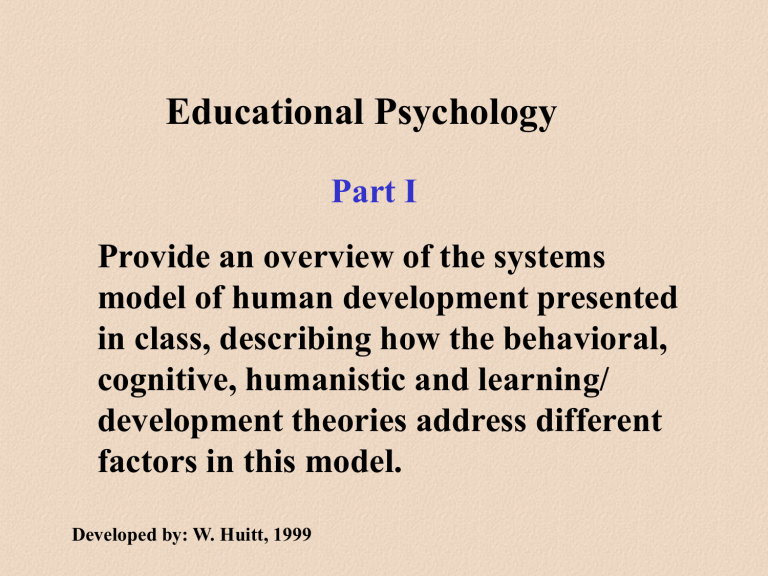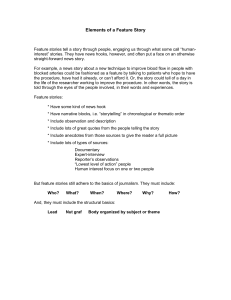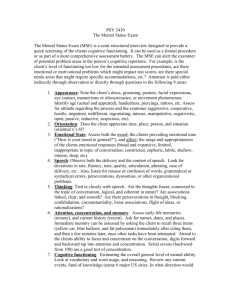Model of Human Behavior I - Educational Psychology Interactive

Educational Psychology
Part I
Provide an overview of the systems model of human development presented in class, describing how the behavioral, cognitive, humanistic and learning/ development theories address different factors in this model.
Developed by: W. Huitt, 1999
Is A Model Necessary?
All data are interpreted vis-à-vis a model.
The model is based on a paradigm.
The “Systems Model of Human Behavior” is an attempt to make the model used in this course explicit.
The model is used as a major organizing construct for the course.
Basic Assumptions
Individuals grow, develop, and change over time as a result of interaction between genetic qualities and particular environment.
Human beings do not develop in isolation.
This approach has been labeled “systems,”
“organismic,” and “contextual/developmental” and “transactional” among others.
Basic Assumptions
Model accepts the ancient perspective of a human being:
• body,
• mind,
• soul/spirit.
Body can be considered in terms of three components:
• genetics,
• physiological structure and functioning,
• overt behavior.
Basic Assumptions
Mind can be considered in terms of three components:
• cognition,
• affect/emotion,
• conation/volition.
Basic Assumptions
There are a variety of ways of validating truth:
• Personal experience
• Intuition
• Social and/or cultural consensus
• Religious scripture and interpretation
• Philosophy and logical reasoning
• Science and the scientific method
Basic Assumptions
View dissonance resulting from using different methods as opportunity to develop new understandings or to integrate previous understandings in new ways.
When you interpret data in a different way, please state your viewpoint as clearly and as concisely as possible, explaining how your interpretation is just as valid, if not more so, than that previously given.
The Basics of the Model
Based on Norman’s (1980) model of the mind and mental functioning:
Cognitive system
Encodes, processes, stores, retrieves, processes information; purpose is manipulation of information
Norman, D. (1980). Twelve issues for cognitive science. Cognitive
Science, 4, 1-32.
The Basics of the Model
Based on Norman’s (1980) model of the mind and mental functioning:
Affective system
Connects the regulatory system and cognitive system; purpose is arousal
Norman, D. (1980). Twelve issues for cognitive science. Cognitive
Science, 4, 1-32.
The Basics of the Model
Based on Norman’s (1980) model of the mind and mental functioning:
Regulatory system
Biological structures that regulate the processing of stimuli and activation of responses; primary purpose is maintenance of the organism
Norman, D. (1980). Twelve issues for cognitive science. Cognitive
Science, 4, 1-32.
The Basics of the Model
The Basics of the Model
The regulatory system is redefined as the aspect of the mental system that regulates input and output functions (not just biological functions).
Other modifications:
• mind receives information and displays action through the body
• adds a biological and spiritual influence
• adds a feedback loop
The Basics of the Model
The Basics of the Model
There are therefore four major components of the individual in this systems model of human behavior:
Cognitive system
Perceives, stores, processes, and retrieves information
The Basics of the Model
There are therefore four major components of the individual in this systems model of human behavior:
Affective system
Can modify perceptions and thoughts before and after they are processed cognitively
The Basics of the Model
There are therefore four major components of the individual in this systems model of human behavior:
Regulatory system
Directs and manages input and output functioning
The Basics of the Model
There are therefore four major components of the individual in this systems model of human behavior:
Behavioral system
Overt action of organism (output of the individual)
The Basics of the Model
It is hypothesized that an individual's thinking
(cognition), feeling (affect), and willing (conation) as well as overt behavior develop as a result of:
• transactions among the various components of mind as
• influenced by biological maturation, bodily functioning and the spiritual dimensions,
• the environment or context of the individual, and
• feedback from the environment as a result of an individual's overt behavior.






